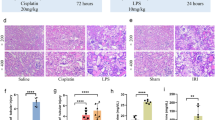Abstract
We investigated whether an in vitro cellbased system can represent toxicity of an in vivo organ using gene expression profiles. We performed an analysis of differentially expressed transcripts, pathway analysis, and Gene Ontology (GO) grouping with the toxicity-induced data following treatments with diclofenac, sulindac, itraconazole, and ketoconazole. The number of genes regulated in vitro and in vivo were much more than the randomly sampled number, but no significant correlation was observed between the in vitro and in vivo experiments. We performed a pathway analysis and GO grouping to expand the approach. In the pathway analysis, we narrowed down the hepatotoxic pathways to focus on toxicity. Then, the percentages of overlapping pathways increased. We found pathways associated with liver function in all experiments, such as the adipocyte signaling pathway, JAKSTAT signaling pathway, and peroxisome proliferatoractivated receptor (PPAR) signaling pathway. In the GO grouping analysis, the clusters obtained were primarily related to lipid metabolic and synthetic processes. The percentage of common GO terms between in vitro and in vivo experiments also increased. Therefore, we identified than an analysis performed at the systems biology level was more correlated for in vitro and in vivo systems.
Similar content being viewed by others
References
Paul, S.M. et al. How to improve R&D productivity: the pharmaceutical industry’s grand challenge. Nat. Rev. Drug Discov. 9, 203–214 (2010).
DiMasi, J.A., Hansen, R.W. & Grabowski, H.G. The price of innovation: new estimates of drug development costs. J. Health Econ. 22, 151–185 (2003).
Adams, C.P. & Brantner, V.V. Estimating the cost of new drug development: is it really $802 million? Health Aff. 25, 420–428 (2006).
Cohn, M. Alternatives to Animal Testing Gaining Ground. the Baltimore Sun ( 2010).
PETA (People for the Ethical Treatment of Animals) http://www.peta.org/.
BUAV (British Union for the Abolition of Vivisection) http://www.buav.org/.
Deng, Y.P. et al. In vitro gene regulatory networks predict in vivo function of liver. BMC Syst. Biol. 4, 153 (2010).
Bort, R. et al. Diclofenac toxicity to hepatocytes: a role for drug metabolism in cell toxicity. J. Pharmacol. Exp. Ther. 288, 65–72 (1999).
Zou, W. et al. Sulindac metabolism and synergy with tumor necrosis factor-á in a drug-inflammation interaction model of idiosyncratic liver injury. J. Pharmacol. Exp. Ther. 331, 114–121 (2009).
Somchit, N. et al. Hepatotoxicity induced by antifungal drugs itraconazole and fluconazole in rats: a comparative in vivo study. Hum. Exp. Toxicol. 23, 519–525 (2004).
Rodriguez, R.J. & Buckholz, C.J. Hepatotoxicity of ketoconazole in Sprague-Dawley rats: glutathione depletion, flavin-containing monooxygenases-mediated bioactivation and hepatic covalent binding. Xenobiotica 33, 429–441 (2003).
Lewis, J.H. NSAID-INDUCED HEPATOTOXICITY. Clin. Liver Dis. 2, 543–561 (1998).
DAVID (Database for Annotation, Visualization and Integrated Discovery) http://david.abcc.ncifcrf.gov/.
Wick, M. et al. Peroxisome proliferator-activated receptor-γ is a target of nonsteroidal anti-inflammatory drugs mediating cyclooxygenase-independent inhibition of lung cancer cell growth. Mol. Pharmacol. 62, 1207–1214 (2002).
Lehmann, J.M. et al. Peroxisome proliferator-activated receptors α and γ are activated by indomethacin and other non-steroidal anti-inflammatory drugs. J. Biol. Chem. 72, 3406–3410 (1997).
Göldlin, C.R. & Boelsterli, U.A. Reactive oxygen species and non-peroxidative mechanisms of cocaineinduced cytotoxicity in rat hepatocyte cultures. Toxicology 69, 79–91 (1991).
Mayhew, C.N. et al. In vivo and in vitro comparison of the short-term hematopoietic toxicity between hydroxyurea and trimidox or didox, novel ribonucleotide reductase inhibitors with potential anti-HIV-1 activity. Stem Cells 17, 345–356 (1999).
Donaldson, K. et al. Concordance between in vitro and in vivo dosimetry in the proinflammatory effects of low-toxicity, low-solubility particles: the key role of the proximal alveolar region. Inhal. Toxicol. 20, 53–62 (2008).
Author information
Authors and Affiliations
Corresponding author
Rights and permissions
About this article
Cite this article
Jo, Y., Oh, JH., Yoon, S. et al. The comparative analysis of in vivo and in vitro transcriptome data based on systems biology. BioChip J 6, 280–292 (2012). https://doi.org/10.1007/s13206-012-6311-4
Received:
Accepted:
Published:
Issue Date:
DOI: https://doi.org/10.1007/s13206-012-6311-4




